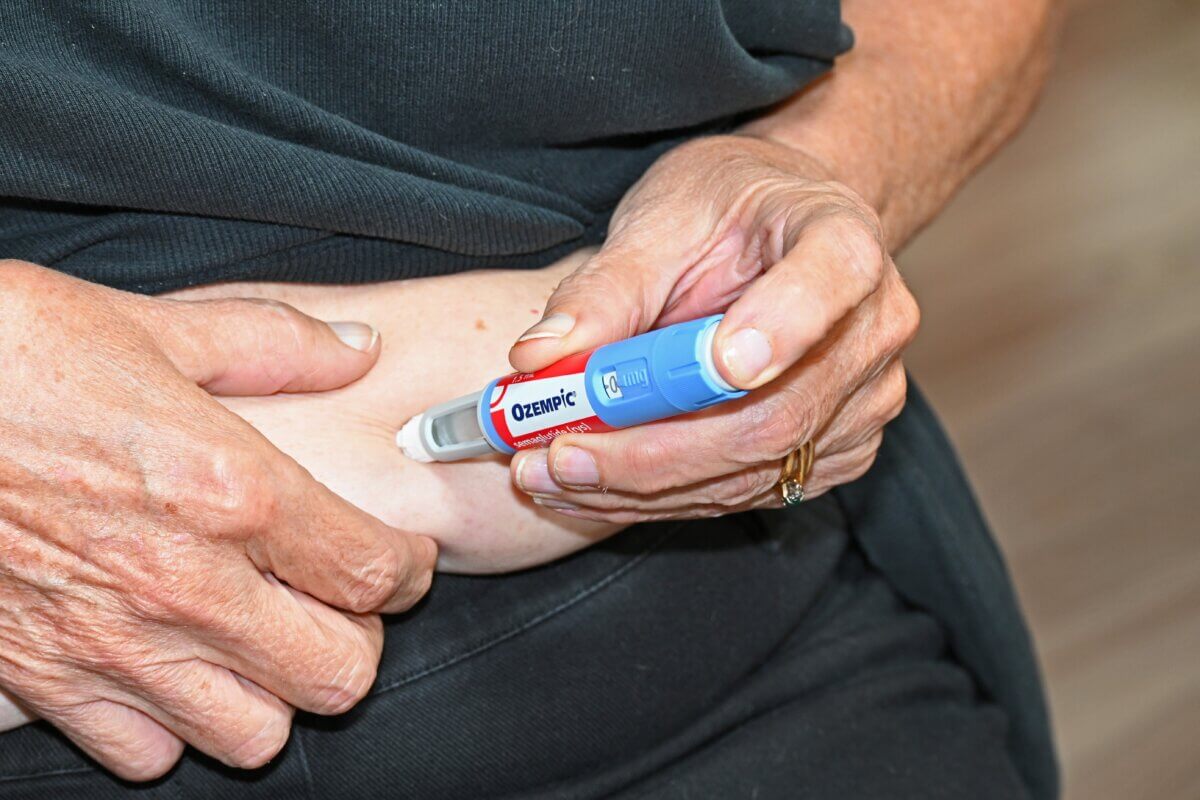
Patient injecting themself in the stomach with an Ozempic (semaglutide) needle. (Photo by Douglas Cliff on Shutterstock)
For a long time, dieting and exercise were the only realistic options for many people who wanted to lose weight, but recent pharmaceutical advances have led to the development of weight loss drugs. These are based on natural hormones from the intestine that help control food intake, such as GLP and GIP.
GLP-1-based drugs such as semaglutide (Wegovy and Ozempic) and tirzepatide (Mounjaro) work by helping people to feel less hungry. This results in them eating less – leading to weight loss.
Studies show that these drugs are very effective in helping people lose weight. In clinical trials of people with obesity, these drugs lead to a weight loss of up to 20% body weight in some instances.
But it’s important to note that not all the weight lost is fat. Research shows that up to one-third of this weight loss is so-called “non-fat mass” – this includes muscle and bone mass. This also happens when someone goes on a diet, and after weight loss surgery.
Muscle and bone play very important roles in our health. Muscle is really important for a number of reasons including that it helps us control our blood sugar. Blood sugar control isn’t as good in people who have lower levels of muscle mass.
High blood sugar levels are also linked to health conditions such as Type 2 diabetes – where having high blood sugar levels can lead to blindness, nerve damage, foot ulcers and infections, and circulation problems such as heart attacks and strokes.
We need our bones to be strong so that we can carry out our everyday activities. Losing bone mass can increase our risk of fractures.
Researchers aren’t completely sure why people lose fat-free mass during weight loss – though there are a couple of theories.
It’s thought that during weight loss, muscle proteins are broken down faster than they can be built. And, because there’s less stress on the bones due to the weight that has been lost, this might affect normal bone turnover – the process where old bone is removed and new bone is formed leading to less bone mass being manufactured than before weight loss.

Because GLP-1 drugs are so new, we don’t yet know the longer-term effects of weight loss achieved by using them. So, we can’t be completely sure how much non-fat mass someone will lose while using these drugs or why it happens.
It’s hard to say whether the loss of non-fat mass could cause problems in the longer term or if this would outweigh the many benefits that are associated with these drugs.
Maintaining muscle and bone
There are many things you can do while taking GLP-1 drugs for weight loss to maintain your muscle and bone mass.
Research tells us that eating enough protein and staying physically active can be helpful in reducing the amount of non-fat mass that is lost when losing weight. One of the best types of exercise is doing resistance training or weight training. This will help to preserve muscle mass, and protein will help us maintain and build muscle.
If you find it difficult to find the time to squeeze in a workout, there are plenty of simple things you can do during your day to help maintain your muscle mass during weight loss. Using the stairs rather than taking the elevator, carrying the shopping in from the car in fewer trips and walking at a slightly quicker pace are all really great ways of incorporating activity into your day.
GLP-1 drugs such as Wegovy, Ozempic and Mounjaro are exciting new tools for weight loss. But evidence suggests that to get the best long-term result from these drugs, it’s important to combine them with healthy changes to diet and physical activity.
Jennifer James is a lecturer in physiotherapy in the Institute of Population Health at the University of Liverpool.
This article is republished from The Conversation under a Creative Commons license. Read the original article.








I should add, mass food producers certainly don’t want to stop making and marketing junk food… it’s very profitable.
Please note, buried in the article is something very important to note… ALL weight loss, no matter how it’s achieved, can lead to bone and muscle loss. What isn’t noted in the article, but recently proven by a top quality study, is that everyone who loses weight will be prone to regain the weight as our cells want to return to their old “set points”. So those who criticize the GLP-1 drugs for weight gain if people stop taking them, should look at the stats for overweight persons who lose weight the traditional way, by dieting. They are also likely to regain. Ask any dieter about this sad fact.
Regain CAN be prevented by carefully sticking with a lower intake diet, but not if people begin to eat they way that got them fat in the first place. It is implied in this article that bone and muscle loss can be reduced, with weight bearing exercise and a high protein diet.
This happens no matter what weight loss method you use, with the exception of surgery just taking out fat itself. The advice about how to reduce the loss goes for all weight loss methods.
I must have been writing my comment the same time as yours. Obviously, we’re both right. I have been reading and listening to the “experts” on the obesity crisis… and it is a crisis for our health. I wish more emphasis was on prevention, but that doesn’t make big Pharma or doctors any money. Weight loss is hard and sometimes miserable, yo yo dieting is frustrating and it’s taking a toll on our health. I am convinced the SAD [standard American diet] is largely to blame, and unfortunately it’s processed junk food is spreading through out the world, replacing traditional healthy diets.